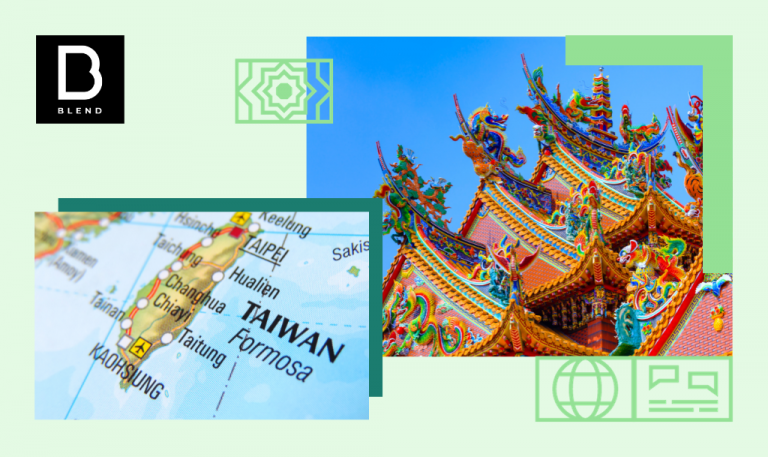Liraz Postan
Liraz is an International SEO and Content Expert with over 13 years of experience.


Taiwan, officially known as the Republic of China, is a relatively small island nation located in East Asia. Despite its modest size, Taiwan boasts a significant population of over 23 million people, making it one of the most densely populated places in the world.
The capital city, Taipei, serves as the political, economic, and cultural center of the country, where people from various backgrounds converge. While Mandarin Chinese is the official language of Taiwan, you’ll find a unique linguistic landscape on the island. English is spoken by around 28.5% of the population as a second language, reflecting its global significance.
However, it’s important to note that English is not an official foreign language in Taiwan. Take a look at the linguistic history of the country and which foreign languages are spoken in Taiwan today, as it reveals the rich tapestry of cultural influences that have shaped this vibrant nation.
Mandarin Chinese has been the official language of Taiwan since 1945 and is the most spoken language in the country. It’s remarkably unchanged from the mainland variant of Mandarin that immigrants brought there, primarily in the 1940s, as they escaped political and military upheaval in that country. Prior to the 1940s, Chinese immigration was often short-term as people sought investment opportunities or fled situations, leaving the local culture and language intact.
Since the main flood of immigration, Mandarin has slowly penetrated every aspect of life. In Modern Taiwan, you would be hard-pressed to find anyone who doesn’t speak Mandarin as at least a third language.
Hokkien and Hakka were the primary local languages displaced by Mandarin. Hokkien, known colloquially as Taiwanese, remains a very common language. In fact, while Mandarin has settled in as the ‘official’ language and the only language used of the government and the law, Taiwanese remains very popular and is usually the common language spoken in everyday life.
Hakka Chinese is still spoken by a small population in Taiwan. The Hakka are an ethnic group within China in the same way Han Chinese are. They have maintained their own Hakka language through the years. Slowly, Hakka is disappearing in Taiwan, supplanted by the twin threats of Mandarin and Taiwanese, however.
The Japanese ruled Taiwan for several decades after China ceded the island to Japan in 1895. As a result, sustained efforts to introduce Japanese to the population continued until 1945. Today, there are still large numbers of older people in Taiwan who speak some amount of Japanese. Japanese also persists as an “elite” language for Taiwan’s business leaders, many of whom studied Japanese and visited Japan while in school.
Other indigenous languages still survive in Taiwan, but generally in very small localized populations that continue to shrink every year. Almost everyone speaks Mandarin and Taiwanese in addition to their traditional languages, and as a result, the motivation to continue to speak and teach these local languages diminishes every year. The Formosan languages are the languages traditionally spoken by the indigenous populations of Taiwan, but even though 2% of the population is Formosan by birth, much less than that still speak their traditional Formosan languages.
The official language of Taiwan is Mandarin Chinese, commonly referred to as “Taiwanese Mandarin.” While Mandarin serves as the standard dialect for formal communication and is used in government, education, and media, Taiwan’s linguistic landscape is rich and diverse.
Additionally, various Chinese dialects, such as Hokkien (also known as Taiwanese), Hakka, and several indigenous languages, are spoken by different communities across the island. Each of these languages has distinct pronunciation, writing systems, and cultural significance. Although Mandarin Chinese is the most widely spoken language in Taiwan. The coexistence of various dialects highlights the cultural diversity and heritage of this dynamic nation, creating a unique and vibrant linguistic tapestry.
Navigating the linguistic intricacies of Taiwan, where the official national language is Mandarin Chinese, alongside the complexities of the Taiwanese language, requires a deep understanding of regional nuances. What language is spoken in Taiwan can vary not only between these two main languages but also across distinct dialects. Accurate translation and localization are of paramount importance to ensure that your message resonates with the local audience and respects their cultural context.
Working with professionals who possess a deep knowledge of the languages spoken in Taiwan and the cultural intricacies is essential. Whether it’s for business, education, or any other field, proficient Chinese translation services are indispensable. The linguistic diversity of Taiwan makes it vital to collaborate with local language experts who can bridge the gap between languages and cultures, ensuring that your message is not only understood but also embraced by the Taiwanese people.
Learn about BLEND English to Chinese translation offers, our professional translation services, as well as localization services.
What our customers are saying